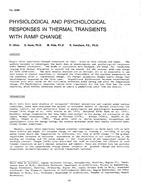Description
People often experience thermal transients in their lives at both offices and homes. The authors intended to investigate the basic data of physiological and psychological responses under thermal transients. Two kinds of experiments were designed, the first for conditions ranging from thermal discomfort to neutral and the second for the reverse, with ramp change for both conditions. The main results obtained are as follows: (1) It is reasonable to use dual scales of thermal sensations to interpret the after-effect of the previous temperature on the responses after a temperature change. (2) Thermal sensations showed faster change than physiological responses in the first case. Significant differences between experimental seasons were also shown on the cool-warm sensation scale during and after the temperature change. (3) Physiological responses varied more vigorously for the hot than for the cold condition, while thermal sensation stayed at nearly a symmetrical point from the neutral.
Units: SI
Citation: ASHRAE Transactions, 1987, vol. 93, pt. 2, Nashville, TN
Product Details
- Published:
- 1987
- Number of Pages:
- 22
- File Size:
- 1 file , 1.8 MB
- Product Code(s):
- D-NT-87-3080




